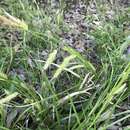Comprehensive Description
provided by North American Flora
Carex cherokeensis Schw. Ann. Lye. N. Y. 1: 71. 1824
Carex recurva Muhl. Descr. Gram. 262. 1817. (Type from "Cherokee.") Not C. recurva Huds.
1778; nor C. recurva Schkuhr, 1801. Edritria recurva Raf. Good Book 26. 1840. (Based on Carex recurva Muhl.) Carex Christyana Boott, Bost. Jour. Nat. Hist. 5 : 114. 1845. (Type from Texas.) Carex baazasana Steud. Syn. Cyp. 236. 1855. (Type from Rio Brazos, Texas.) Carex brazasana Steud.; Bock. Flora 39: 321. 1856. (Correction in spelling only.)
Cespitose, the rootstocks stout, tough, elongate, ascending, blackish, covered with the persistent leaf-bases, the culms 3-6 dm. high, slender but erect, exceeding the leaves, strongly phyllopodic, obtusely triangular, smooth, except in the inflorescence, strongly darkened but not fibrillose at base; leaves (not bracts) usually 4-10 to a fertile culm, mostly clustered toward the base, not septate-nodulose, strongly striate, the blades thick, flat or channeled at base, light-green, long-attenuate, usually 1-2.5 dm. long, 3-7 mm. wide, roughened toward the apex, the sheaths glabrous, copper-brown-tinged ventrally, concave at mouth, the ligule very short; terminal spike staminate, usually with one or two additional smaller staminate spikes at base occasionally pistillate above, peduncled, linear, 2.5-6 cm. long, 2.5-4 mm. wide, many -flowered, the scales closely appressed, ovate-oblong, rounded on back, obtuse, whitish-hyaline with greenish or yellowish center; pistillate spikes usually 3-6, the lower often in pairs or even threes, erect or somewhat drooping, widely separate, the lower on long slender rough peduncles, the upper shorter-peduncled, oblong-cylindric, 1.5-4.5 cm. long, 6-9 mm. wide, containing 10-50 closely arranged appressed-ascending perigynia in several rows; bracts leaf-like, reduced upward, the sheaths long, the lower 2-8 cm. long, even the uppermost well-developed; scales lanceolate, acuminate, thin, greenish-white with green midvein, often somewhat brownishtinged, narrower and usually somewhat shorter than the perigynia; perigynia ovoid, 5-6 mm. long, 2.5 mm. wide, obscurely flattened, globose-triangular in cross-section, somewhat inflated, greenish-straw-colored, membranaceous, several-nerved, rounded at base, somewhat abruptly contracted at apex into a slender beak one fourth the length of the body, scarious and bidentate at apex, the orifice obliquely cut; achenes obovoid, 2-2.5 mm. long, 1.5-1.75 mm. wide, brownish-black, granular, triangular, the sides concave below, the angles prominent and lightcolored, short-stipitate, prominently slenderly (often bent-) apiculate, jointed with the straight slender style; stigmas 3, slender, long, reddish-brown.
Type locality: "Cherokee," and as given by Schweinitz and Torrey: "Hab. the Cherokee country. Mrs. Gambold."
Distribution: In the low country, Georgia to Texas, and northward to southeastern Missouri and Oklahoma. (Specimens examined from Florida, Georgia, Alabama, Mississippi, Louisiana, Texas, Oklahoma, Arkansas, southeastern Missouri.)
- bibliographic citation
- Kenneth Kent Mackenzie. 1935. (POALES); CYPERACEAE; CARICEAE. North American flora. vol 18(5). New York Botanical Garden, New York, NY

